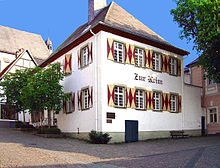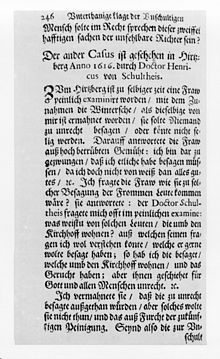Heinrich von Schultheiss
Heinrich von Schultheiß (* 1580 in Scharmede near Salzkotten in the prince-bishopric of Paderborn , † 1646 probably in Arnsberg ) was a witch commissioner in the Duchy of Westphalia . He was significantly involved in the Westphalian witch hunt. But he became known as a witch theorist primarily through pamphlets in defense of witch trials.
Family background and education
If it is correct that the Schultheiss was the son of Heinrich Schulte from Scharmede in the then prince-bishopric of Paderborn, he came from a wealthy, large-scale family. Father Heinrich was also the official representative of the authorities and was related to the clerical and secular nobility of the territory. The young Heinrich grew up at a time when the Counter Reformation under Bishop Dietrich von Fürstenberg ( 1585 - 1618 ) reached its climax in the bishopric. Under him who took the Jesuits , the cathedral school , which also visited Henry. It is unclear to what extent these were formative for his position on the witch question. For his later development, however, it is noteworthy that his father was already involved in a witch trial as a lay judge in 1597, in which twelve women were convicted and executed. Albeit in vain, the father was sued by the son of a convict for perversion of justice before the Reich Chamber of Commerce. The zeal for persecution of Bishop Dietrich in the Paderborn region and his brother Kaspar von Fürstenberg as Landdrost in the Duchy of Westphalia are also likely to have been influential .
In addition to his father's support, a small spiritual benefice enabled him to study law in Cologne and Würzburg . His legal teachers left no doubt about the necessity of the witch hunt on the basis of the Malleus Maleficarum , but pleaded for the jurisdiction of secular courts. Schultheiss completed his studies with the degree of a doctor. He gave up his spiritual benefice and entered the service of Archbishop Johann Schweikhard von Kronberg from Mainz as a secular expert on Roman law . He married Adelheid Kemp, a relative of the Electorate of Cologne Chancellor Dr. Johann Kemp. Last but not least, this kinship contributed to the change to the service of the Cologne electors.
Act as a witch judge
Around 1610, Schultheiss was first commissioner at the court in Cologne and around 1614 came to Arnsberg in the Duchy of Westphalia. There he was initially electoral councilor and “advocatus fisci” (ie representative of the tax authorities in litigation with subjects). He was a member of the electoral central administration and had good relations with both his superiors, the land droves Kaspar and Friedrich von Fürstenberg. His relationship with Ferdinand Archbishop of Cologne was also trusting.
The Bonn court and the electoral officials in the duchy endeavored to enforce the rights of the (distant) elector against the estates in the course of the formation of the state in the early modern period. Although these efforts have essentially had limited success, this professional background is indicative. The phenomenon of the witch trials in the 17th century was not a relic of the Middle Ages, but rather in a certain sense part of the early modern modernization process and the denominational age. Especially with Schultheiss, the fight against the “witchcraft” and the fight against Protestantism are difficult to separate.
As a witch trial commissioner, Schultheiß led the witch trials in Hirschberg in 1616 , in Arnsberg in 1621 and in 1628 worked in this function in the Erwitte Gogericht . The last trials that can be ascribed to him took place in Werl in 1643. Formally, the witch commissioners were only advisors to the courts, but in fact they have a judicial function. Mayor obtained the confessions necessary for a conviction through leading questions and torture. On several occasions, the accused endured the torture and had to be released. But many times they were arrested again, died under torture, or were sentenced at the following trials.
In addition, he was involved in proceedings against high treason in the Diocese of Paderborn in 1623 and was responsible for various death sentences and the execution of supporters of the Protestant military leader Christian von Braunschweig . Schultheiss's activity as a witch hunter coincided in the 1630s with the height of the witch hunts. According to Decker, there were over 600 executions in the Duchy of Westphalia between 1628 and 1631 alone. There is evidence that Schultheiß was involved in trials in Anröchte , Oestereiden , Erwitte and Arnsberg.
In addition to the numerous largely unknown convicts, the witch judge's Henneke von Essen also fell victim to a colleague in the service of the electoral state and multiple mayor of the residential city of Arnsberg.
In gratitude for his services rendered, the elector mayor, mayor, rose to the nobility in the early 1630s. He had a remarkably modern career behind him. Although his father was an economically large landowner, he remained legally independent. On the other hand, through education and protection, his son managed to rise not only into the educated middle class, but even into the nobility. His lifestyle also did not move clearly between the stands. On the one hand, the systematic acquisition of land and the construction of a “pleasure house” in Dickenbruch near Arnsberg speak in favor of an attempt to copy a noble lifestyle. On the other hand, the purchase of a sawmill is evidence of a strong bourgeois drive to earn a living. In the city of Arnsberg, Schultheiss lived in a house directly on the market square and in the immediate vicinity of the town hall. Whether the popular name "Himmelspförtner Haus" refers to the work of mayor as a judge in witch trials is of course controversial. The "Himmelspförtner Haus" is a house on the property of the later restaurant Zur Krim .
The advance of Protestant troops in the course of the Thirty Years' War prevented further rise . As early as 1633, Schultheiss had to flee to Cologne, where he also had his work on witch trials (see below) printed. After his return to the Duchy of Westphalia in 1643 he was involved in the "magic trials" in Werl .
In the witch trials he played a disastrous role because he showed no mercy for the victims. Schultheiss's procedure corresponded to the usual procedure at the time. Due to denunciations, arrests, tortures, confessions and sentences were made. He probably died in Arnsberg in 1646 .
Author and theoretician of the witch trials
Today Schultheiß is notorious above all for his book “Detailed Instruction How to proceed in Inquisition things of the increased vice of magic ...” from 1634. With about 500 pages, this book was quite considerable. However, it was not so much a scientific and legal work in the narrower sense, but a writing that was primarily aimed at the nobility in their capacity as holders of patrimonial jurisdiction. Both the German language and the form of dialogue in writing speak for this. In terms of content, it was only partly a guide on how to conduct a witch trial. In addition, the justification of one's own actions, for example in the case of the mayor of Essen, in the Duchy of Westphalia and the Paderborn monastery, played an important role.
Remarkably, Schultheiss only dealt indirectly with the contemporary Friedrich Spee von Langenfeld, who was also closely connected to Paderborn, and his pamphlet " Cautio criminalis, seu de processibus contra Sagas Liber ", which was directed against the witch trials .
The extent to which Schultheiss's writing actually had an influence is unknown, as it is not clear in which edition it was published. Five copies still exist today. His book was also controversial among contemporaries. Rather, they have often judged the work negatively.
The book Hochnötige Unterthanige Wemütige Klage Der Pious Invalid by the Amsterdam businessman Hermann Löher from 1676 gives z. E.g. on p. 246 there is an interrogation of the then Hirschberg judge Heinrich von Schultheiss from 1616, who interrogates a defendant, the Wintersche, and suggests answers. The Hirschberg pastor Michael Stappert spoke to this accused and made these notes.
How anachronistic the book by Schultheiss was, shows the distance from Elector Ferdinand of Cologne, who was himself one of the persons responsible for numerous witch trials. A report from his own “alma mater” at the University of Cologne was downright catastrophic for the author. Among other things, it said: The Schultheiss writing "is based on uncertain foundations, namely on human conjecture, on dissolute, wicked reflection ..."
Publications
- A detailed instruction how to proceed in Inquisition matters of the growing vice of magic against the magic of the divine majesty and of Christendom enemies without the risk of the innocent ... , Cologne 1634 ( digital copy )
literature
- Rainer Decker: The Arnsberg witch judge Dr. Heinrich von Schultheiss (approx. 1580–1646) . In: Arnsberger Heimatblätter , vol. 16 (1995), pp. 22-35.
- Peter Arnold Heuser / Rainer Decker: The theological faculty of the University of Cologne and the witch hunt. The witch trial instruction (1634) by the Arnsberg lawyer Dr. Heinrich Schultheiss as reflected in a faculty report from 1643. In: Westfälische Zeitschrift Vol. 164 2014 pp. 171–219
- Tanja Gawlich: The witch commissioner Heinrich von Schultheiß and the witch persecution in the Duchy of Westphalia . In: Harm Klueting (Ed.): The Electoral Cologne Duchy of Westphalia from the beginnings of Cologne rule in southern Westphalia to the secularization of 1803 . Aschendorff, Münster 2009. ISBN 978-3-402-12827-5 . Pp. 297-320.
Web links
Individual evidence
- ↑ Gawlich, pp. 310-314
| personal data | |
|---|---|
| SURNAME | Schultheiss, Heinrich von |
| BRIEF DESCRIPTION | German witch hunter |
| DATE OF BIRTH | 1580 |
| PLACE OF BIRTH | Scharmede near Salzkotten, Principality of Paderborn |
| DATE OF DEATH | 1646 |
| Place of death | uncertain: Arnsberg , Duchy of Westphalia |


